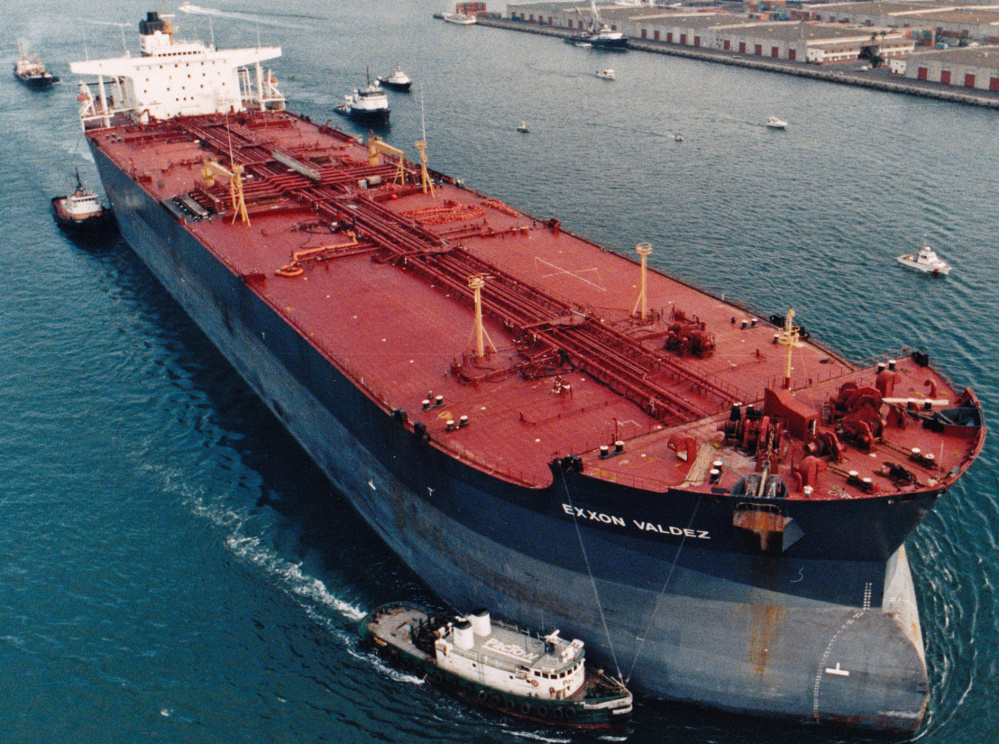In the wee hours of March 24, 1989, the channel connecting the Alaskan port of Valdez with Prince William Sound was riddled with icebergs shed from the deteriorating Columbia Glacier, a massive river of ice that had begun breaking apart only a few years earlier.
With an inexperienced third mate guiding the massive, oil-laden tanker, the Exxon Valdez swerved out of its designated shipping lane to avoid the ice. It was a standard maneuver carried out hundreds of times before.
But this time, on this night, before the third mate could correct course, the tanker careened into the outcropping of Bligh Reef, where it ultimately released roughly 11 million gallons of crude oil into the waters of Prince William Sound.
That such a catastrophe might happen was not news to the company.
Beginning in 1975, the U.S. Geological Survey warned Exxon and its co-investors in the Trans-Alaska Pipeline System – including companies now part of BP and Conoco-Phillips – that the glacier was becoming unstable.
What was triggering the glacier to drop icebergs at such a ferocious and ultimately disastrous pace was unclear at the time. But some scientists, even then, were beginning to look at climate change’s role.
In 1978, a news article in the scientific journal Nature reported that the USGS was “concerned that the glacier could, as a result of changing climatic conditions, experience a ‘drastic retreat’ which might result in … a major hazard to shipping.” Similar accounts of the USGS warnings appeared in the Los Angeles Times and Time magazine, among other publications.
GLACIOLOGISTS NOTE CLIMATE CHANGE
In the decades following the accident, as Exxon publicly questioned the risks climate change posed both to society and its own operations and assets, a growing number of glaciologists identified climate as a factor in one of world’s largest and costliest environmental disasters.
While glaciers grow and retreat over decades and centuries, most of the planet’s glaciers are now shrinking at unprecedented rates, leading scientists to conclude with confidence that a changing climate is the culprit.
“There is no question now that climate change is responsible for both the initial breakup” of the glacier, due to decreased precipitation in the region and its “continued retreat due to higher global temperatures,” said Wendell Tangborn, a retired USGS geologist who studied the Columbia Glacier in the 1980s and 1990s.
In 2015, the Energy and Environment Reporting Project at Columbia University’s Graduate School of Journalism and the Los Angeles Times documented the complicated relationship Exxon (today known as Exxon Mobil) had with climate change science, risk and disclosure during the 1980s, 1990s and early 2000s. The website InsideClimate News also published an investigation into the company’s early climate research.
The Exxon Valdez oil spill was one of the earliest and most devastating examples of the risks posed by a changing climate, many scientists now say – one that ultimately resulted in the polluting of a pristine sound and the destruction of local fisheries, and cost Exxon a total of $3.4 billion through 2008 in cleanup costs and court settlements.
A number of factors, including an inebriated captain Joseph Hazelwood who had retired to his stateroom, an overworked crew and lax regulatory oversight, led to the accident. But it was the icebergs from the deteriorating glacier that created the treacherous conditions that forced the ship to veer off course.
This story is the result of dozens of interviews with scientists, government officials and oil industry employees, as well as a review of documents obtained from the U.S. Geological Survey, U.S. Coast Guard, National Archives, National Transportation Safety Board, Vanderbilt University, University of Alaska and the Exxon Mobil Historical Collection at the University of Texas at Austin’s Briscoe Center for American History.
For the two decades following the Exxon Valdez disaster, the company worked quietly to safeguard its operations and infrastructure against steadily rising sea levels and thawing permafrost. Yet in public, it vociferously fought regulations and policies that would have limited fossil fuel emissions, while publicly questioning the science behind climate change.
Investigations into the company have been launched by attorneys general in California, New York, Massachusetts and elsewhere concerning its disclosure of climate risks to shareholders for the last 40 years.
Alan Jeffers, an Exxon Mobil spokesman, challenged The Times and Columbia’s findings as false and misleading, and said in an email that on the issue of the glacier, there is no “causal link between the Valdez oil spill and climate change.”
In another email, Jeffers said the accident was one of the most investigated incidents in American maritime history, generating numerous lawsuits, trials, jury verdicts and court decisions. None of the parties in those cases, he said, accused Exxon of failing to disclose “the alleged risks associated with the accident that you assert.”
“As we have stated many times, Exxon Mobil believes the risk of climate change is real and warrants action,” Jeffers said.
THE TRAIL TO DISASTER
The trail that led to the Exxon Valdez disaster began in 1968, when Humble Oil, one of two companies that would eventually consolidate to form Exxon, discovered a massive reservoir of crude oil in the Alaskan Arctic.
To get some of those 25 billion barrels to customers in California and elsewhere in the Western United States, Exxon and its co-investors joined forces to build an 800-mile-long pipeline stretching from the oilfield in Prudhoe Bay to the port of Valdez.
The port of Valdez was chosen as the endpoint of the pipeline mainly because it was considered “ice-free,” meaning it did not freeze during the winter, and was therefore safe for oil tanker traffic, according to an environmental impact assessment at the time.
A MAJOR THREAT TO OIL TANKERS
To reach the open waters of Prince William Sound, oil tankers had to traverse a narrow channel called the Valdez Arm and bypass the Columbia Glacier, which in the 1970s was considered stable.
But a year into construction, on Aug. 25, 1975, a glaciologist for the U.S. Geological Survey created a stir with an appearance on the NBC nightly newscast.
“Valdez was picked as a pipeline terminus because that bay is open year-round,” said Tom Brokaw, the network anchor introducing the segment. But, he added, “that may not always be the case.”
The glaciologist, Austin Post, told viewers the glacier was likely to begin a drastic retreat resulting in “a massive ice pack moving out into Prince William Sound.”
In other words, it was a major threat to the oil tankers navigating the Valdez waters.
Post’s predictions “stirred the stockholders and the pipeline company, and the problem came rattling down the whole chain and landed on my desk,” Richard Reger, a geologist contracted by the pipeline company Alyeska to look into the situation, recently recalled.
In December of 1975, Post and his boss, Mark Meier, the chief glaciologist at USGS, flew to Anchorage to meet with high-level executives at Alyeska and its member companies.
Abraham Mookhoek, Exxon’s representative at the meeting, was “quite vocal and appeared to be genuinely impressed with the problem,” Meier wrote in a memo after the meeting.
But other company officials were less sure.
“You know, there is nothing definite,” William Fisken, an Alyeska official, said at a public forum the day after meeting with Meier and Post. “It is like trying to forecast an earthquake.”
Send questions/comments to the editors.





Comments are no longer available on this story